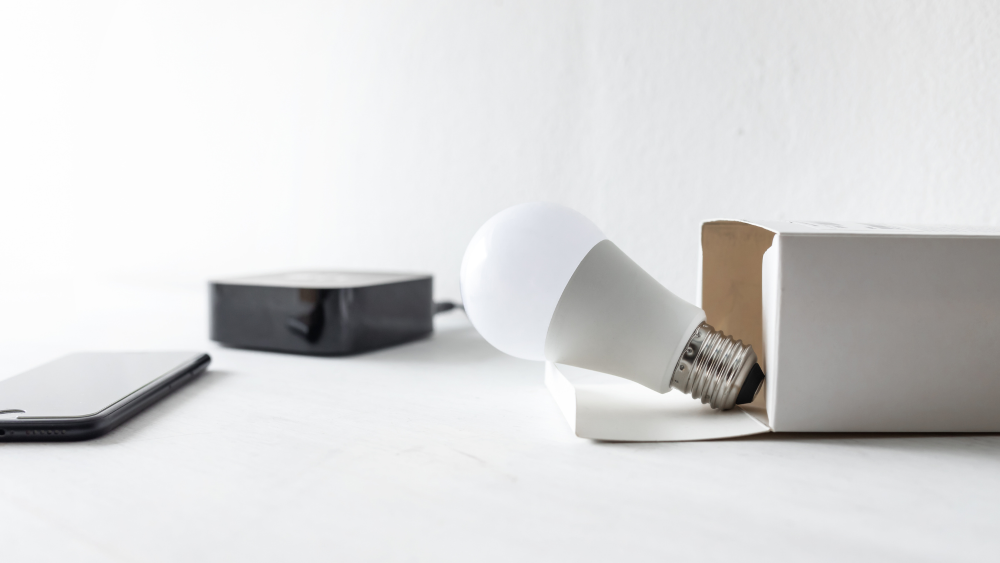Last year, humans threw away 63.3 million US tons of e-waste. And that number is on track to grow by 28 percent by the end of the decade, thanks to shorter product lifecycles, limited repair options and an insatiable appetite for electronics. So how do we deal with this problem? One way is to be smarter about the devices we bring into our homes. Smart tech is only smart if, beyond innovation and convenience, it also offers a real solution to a real problem (and doesn’t have to be swapped out for a newer model every year).
Whether you’re internet window shopping or building your dream green home from scratch, you can reduce friction, bring long-term value to your property and lower your carbon footprint with these smart home devices.
LED lighting
Why it’s smart: LED lights bring convenience, customization, programmability and energy efficiency to home lighting—and not just during the holiday season. Imagine lighting that adjusts to the time of day or what you’re doing, turning on when you pull into the driveway, dimming when you watch a movie, providing bright, focused light while reading. With potential benefits like reduced eye strain and improved sleep quality, no wonder US smart light ownership jumped from 12 to 20 percent in 2021.
Why it’s sustainable: LED lights use semiconductors to break away from the constraints of incandescent bulbs, consuming 75 percent less energy and lasting over 20 times longer. And when paired with sensors, smart LED systems can be programmed to only turn on when they detect motion, conserving even more energy.
Wi-Fi thermostat
Why it’s smart: While 41 percent of American households have programmable thermostats, fewer than one third of those actually use them. Now, a robot can do it for you: The latest generation of Wi-Fi thermostats use artificial intelligence to automatically adjust the temperature based on whether you’re at home, analyze usage patterns to find hidden cost savings, factor in utility time-of-use rates and respond to voice or smartphone commands. They can also put money back in your pocket, saving you 10 to 15 percent of your annual heating or cooling bill, or about $140 on average.
Why it’s sustainable: The residential sector consumed 1.46 trillion kilowatt-hours of electricity last year; the biggest piece of that pie was for heating and cooling our homes. By 2050, it’s estimated roughly 60 percent of American homes will be equipped with a smart thermostat, reducing carbon dioxide emissions by up to 7.4 gigatons.
Smart vents
Why it’s smart: While Wi-Fi thermostats regulate the average temperature of your home, smart vents control airflow to individual rooms (assuming you have a forced air system). If some corners of your house are always too hot or too cold—a sign your HVAC system isn’t balanced—smart vents can automate room temperature based on preference and use.
Why it’s sustainable: Smart vents help reduce energy consumption by redirecting it where it’s needed. Depending on the size of your home—those in larger, draftier houses are bound to benefit more—and the state of your HVAC system, you might save around 20 percent on your heating and cooling bills.
Water vapor fireplace
Why it’s smart: By creating a hyper-realistic illusion of flames using water mist and LED lights, this zero-carbon alternative to traditional fireplaces costs half the price and is cool to the touch. And if you want to turn up the temperature, some models come with electric heaters.
Why it’s sustainable: Whereas traditional wood-burning fireplaces release polluting fine particles into the air, water vapor alternatives use only water and a small amount of electricity, consuming around the same amount of energy a space heater would.
Residential solar power
Why it’s smart: Do you know how your home’s electricity is produced? This interactive map sheds light on the resources—fossil fuels, nuclear energy, renewables like wind, hydro and solar—that the power plants in your region rely on. Though fossil fuels still account for 61 percent of electricity generated in the US, the residential solar market saw its fifth consecutive year of record growth in 2021. That’s in large part thanks to a 60 percent price drop over the past decade. Solar electricity can be used to power everything in your home (and your garage, including your electric vehicle), stored in a backup battery for outage protection or sold back to the grid.
Why it’s sustainable: Each residential solar panel system offsets the carbon emissions created by one internal combustion engine vehicle each year. (And that’s in addition to saving you $10,000 to $30,000 over a 20 year-period.)
Smart meets sustainable
While there are no shortage of home automation devices, only a select few can make your life easier while also saving you money and protecting the planet. Those are the ones that are truly worth inviting into the home.


